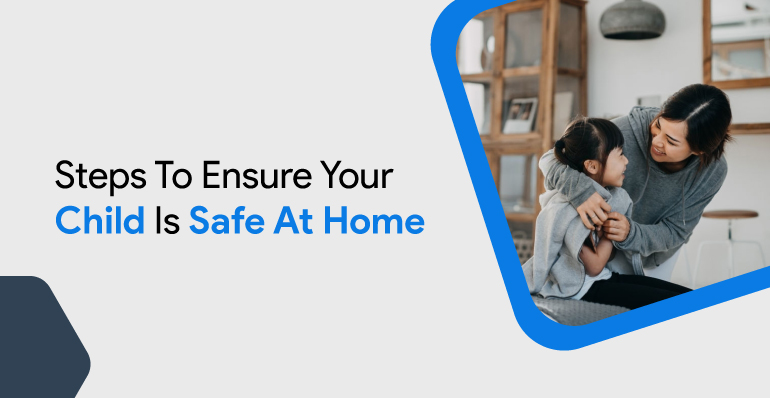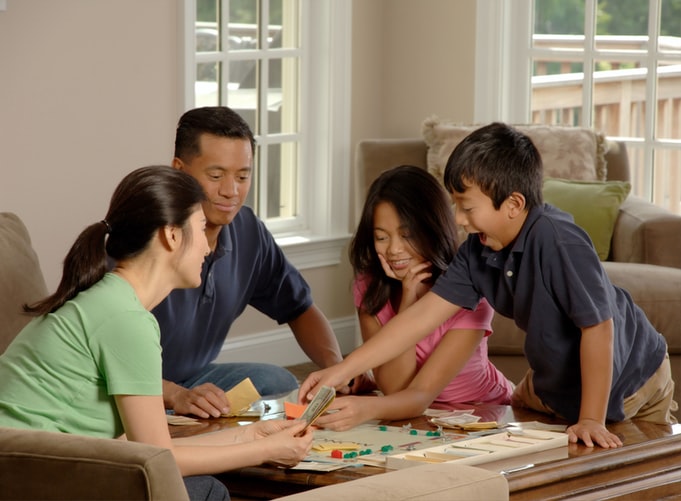Steps To Ensure Your Child Is Safe At Home

Steps To Ensure Your Child Is Safe At Home
Parents should ensure that their child is safe at home. Only having some safety gadgets at home doesn’t make your child safe. Every house culture and rules set by you will promote your child’s safety. It will help if you teach your kid what is safe and what can harm. It’s important to make sure that your child is safe both in your presence and absence. Parents should be aware of every injury possible at home.

Children are more injury-prone at home as compared to other places. You must ensure that your kids are safe in your presence or absence. You can reduce the risk of injury by removing potential hazards from home and installing safety products. Every chore of the house should be properly inspected, and plan safety measures and rules according to that.
There is a high chance of having people around us capable of hurting innocent children. Criminals also choose their victims at random. Kids are easy predators to harm, kidnap, and kill.
Are you prepared for some emergencies?
If some emergency occurs, from where do you get help? Emergency information and a contact list should be near to every phone in the house. Find first aid and CPR fundamental learning. Keep the supplies of first aid on hand. These things help you to ensure that your child is safe at home when you are out.
Why is it necessary to teach your child safety measure?
To prevent your kid from various issues like bullying, accidents, mental problems, and so on, it is best practice to teach your safety measure to your child. When they have an idea about safety measures, they know what to do and what not to do when they encounter a dangerous situation. As a result, they will respond according to it.
You believe that your child is safe at home, and in case they feel awkward because of some guest’s activities, they will tell you. Safety measures will help to decrease the risk of your child.
That’s why to protect your child both inside and outside the house; it is necessary to teach your child safety measures.
Safety Measures To Keep Your Child Safe is At Home
Kids are innocent enough to know the darker side of the world. They need to be taught and aware of the possible risk around them, even at home.
Make sure your kid keeps the door shut
Closing the door is the first measure to apply at home. This ensures that the intruders do not have access to the house and that smaller children do not come out. If the door is locked, you can trust that your children are well secured indoors.
It will be easier to guarantee their protection when they are infants since many safety measures can be used on the market. It would be more difficult with the rise of their age.
Let your child memorize essential numbers and addresses
It is important for preschoolers. You should make your kid remember your home phone number and, if possible, your address. It will allow the tracking of you by authorities if they get lost in a mall or park.
Some of these emergency numbers should be stored by the kid. The number of emergencies is usually only four so that your child can quickly remember them. Those who cannot store the information only begin by teaching them their full names and other fundamental information.
Tell your kid to stay away from strangers
You can not always be available to your child, particularly once they begin school. The only thing you can do is make sure they understand the concept of “stranger risk.” And they are not allowed to trust strangers. Trusting strangers and accepting gifts and food from strangers should be avoided.
Playing on-road may harm their lives
Every motorist on the road is in a rush to get somewhere. So you need to trust your instinct and encourage your kid not to play on the road. Often teach your children to play in a designated place like lawn, backyard, and close to your house. In this situation, they may not notice kids playing out there and harming them.
Teach them about their body with a bad touch and good touch
The number of children being sexually assaulted by strangers and even people they know is on the increase. It is crucial to ensure that children are aware of the dangers surrounding them from an early age. Teaching children about their bodies at a young age will also protect them from being misled by misinformation on the internet.
Make sure your child shares only limited information online
Kids are an easy target to get personal information. Anyone can misuse your details, and you never know where you find yourself in the future. Even if you delete everything, there may be backups or screenshots somewhere. That’s why you need to teach all essentials to your child about social media.
Posts there on the internet from kids can make their career or break their career. Kids need to know about the permanency of the internet. Some traces and trails remain there somewhere even if we delete them. So make sure your kid only shares limited information out there on the internet to ensure your child is safe at home.
Teach kids to stay away from unknown or dangerous products
You must teach your child to avoid certain hazardous products as a safety precaution. When the children are old enough to differentiate between harmful and not, educate them about the products, they can not manage independently.
Please make certain that they do not have access to medicine cabinets or drawers containing knives. By doing so, you significantly reduce the risk of an accident happening in your home.
Encourage your kid to chill out with their friends in your own home
Encourage your child to bring their friends to your home because it will help you to know them better. And then you can decide which of their friend is good for them and which will negatively influence them. Along with that, build a strong relationship with the parents of your child’s friend. It is better and safe that your child spends time in his own house than playing on the road and parking.
Teach your child some self-defense techniques
If your child faces some bullying and feels attacked, the self-defense technique you give will help them. Bullying can negatively hamper the self stream, but self-defense technique powers them.
You can give karate classes that help fight back against criminals and offenders.
Talk with your kids regularly
Have a regular conversation with your child discussing their daily life ongoing activities. Make them feel their parents will be there and understand them. Ask them a few safety questions, like what they will do when finding themselves in a problem. How do you think I would respond when you share your secrets. This will help you to know what is inside them and what they feel about you.
Tips and Tricks To Keep Your Kids Safe At Different Areas Of Home

Even your own home is not that secure for your child sometimes. Following are some general tips and tips according to the area of the house:
General house tips to keep your child safe at home:
- Have a Look for potential safety hazards in your home through the eyes of your kid. Get down on your hands and knees and take a look around. Consider what a child finds appealing.
- Plug protectors should be used on all unused electrical outlets. When not in use, unplug electrical appliances.
- A wall brace may be used to protect large TVs and other heavy furniture. This stops them from collapsing. Often, use a TV stand that is the right size for your TV.
- Keep small toys, plastic bags, balloons, and other objects that could pose a choking hazard out of rooms.
- Window stops can be used to keep windows from opening more than 4 inches. Open the windows from the top as well.
- Put up a shield around fireplaces and other sources of heat.
- Keep all houseplants out of sight of children.
- Nowhere in the house should a weapon be held. If you must keep one, keep all gun-related materials locked up while not in use.
- To avoid accidents, keep furniture edges and corners protected.
- Furniture should be kept away from walls. It stops kids from running up on the furniture and slipping out the window.
- For little children:
- Using a non-wheeled baby walker instead. This form of walker is risky, particularly near stairs.
- Mount the gates at both the top and bottom of the stairs if necessary.
Some kitchen tips:
- Keep out sharp utensils, Knives, and scissors out of the reach of children.
- Maintain a functional fire extinguisher in the kitchen. Make clear that all adults in the house understand how to use it.
- All harmful household items, such as cleaning supplies, medications, and vitamins should be stored with caution. Hold them in their original packaging. And keep them out of sight of children by putting them in a drawer.
- Do not use tablecloths. Small hands may grip them and pull dishes and other things onto small heads.
Some bathroom tips:
- To avoid slips, keep non-skid bath mats on the floor and in the tub.
- Unplug hair dryers and other electric appliances and keep them out of children’s control.
- Always keep a close eye on young children in the toilet to avoid drowning. Keep a close eye on them when they’re in the bath. Never leave a child unsupervised in water. When done, empty the sink or shower.
- To prevent toddlers from drowning, use toilet seat locks.
- To avoid scalding, keep your water heater at 120°F (48.9°C) or lower. Be mindful that a child’s skin is more susceptible to heat and can burn more quickly than an adult’s.
Some kid’s playroom or bedroom tips:
- Check to see if the toy box has a heavy lid that could trap your child. Install a protective hinge to keep the lid open or remove it.
- Hold the bed as far away from the windows as possible.
Final Thoughts
Toddlers and preschoolers need constant supervision. And school-aged children need assistance in learning how to stay safe. Starting these lessons at a young age will help children stay healthy for the rest of their lives.
Don’t forget to teach necessary safety tips and keep an eye on every possible danger around household chores. Above are some of the steps to ensure your child is safe at home.
Suppose you want to learn about parenting in the digital age. If you have any concerns about your child’s care and safety, please leave a comment below.



 WhatsApp Spy
WhatsApp Spy Facebook & Messenger Spy
Facebook & Messenger Spy Viber Spy
Viber Spy Instagram Spy
Instagram Spy Skype Spy
Skype Spy TikTok Spy
TikTok Spy Telegram Spy
Telegram Spy LinkedIn Spy
LinkedIn Spy Twitter Spy
Twitter Spy Youtube Spy
Youtube Spy Photo Spy
Photo Spy Video Spy
Video Spy Calls and Contacts Tracking
Calls and Contacts Tracking SMS & IM Chats
SMS & IM Chats Voice Capture
Voice Capture Image Capture
Image Capture Video Record
Video Record